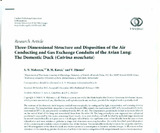Three-Dimensional structure and disposition of the air conducting and gas exchange conduits of the Avian lung: The domestic Duck ( Cairina moschata)
| dc.contributor.author | Mukanya, AN | |
| dc.contributor.author | Kavoi, BM | |
| dc.contributor.author | Djonov, V | |
| dc.date.accessioned | 2014-06-21T09:48:31Z | |
| dc.date.available | 2014-06-21T09:48:31Z | |
| dc.date.issued | 2014 | |
| dc.identifier.uri | http://hdl.handle.net/11295/70253 | |
| dc.description | Journal Article | en_US |
| dc.description.abstract | The anatomy of the domestic duck lung was studied macroscopically. by casting and by light. transmission. and scanning electron microscopy. The lung had four categories of secondary bronchi (SB). namely. the medioventral (MV. 4-5). laterodorsal (LD. 6-10). lateroventral (LV.2-4). and posterior secondary bronchi (PO. 36-44). The neopulmonic parabronchi formed an intricate feltwork on the ventral third of the lung and inosculated those from the other SB. The lung parenchyma was organized into cylindrical parabronchi separated by thin septa containing blood vessels. Atria were shallow and well-fortified by epithelial ridges reinforced by smooth muscle bundles and gave rise to 2-6 elongate infundibulae. Air capillaries arose either directly from the atria or from infundibulae and were tubular or globular in shape with thin interconnecting branches. The newly described spatial disposition of the conducting air conduits closely resembles that of the chicken. This remarkable similarity between the categories. numbers. and 3D arrangement of the SB in the duck and chicken points to a convergence in function-oriented design. To illuminate airflow dynamics in the avian lung. precise directions of airflow in the various categories of SB and parabronchi need to be characterized. | en_US |
| dc.language.iso | en | en_US |
| dc.publisher | University of Nairobi | en_US |
| dc.title | Three-Dimensional structure and disposition of the air conducting and gas exchange conduits of the Avian lung: The domestic Duck ( Cairina moschata) | en_US |
| dc.type | Article | en_US |

